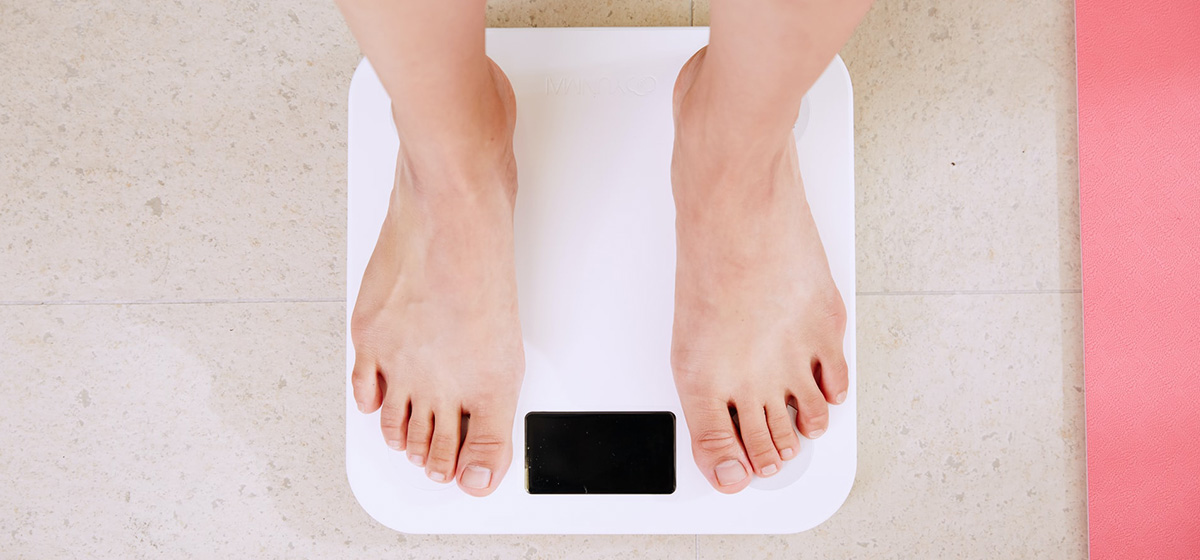What Determines a Healthy Body Weight?

Question: “How can I determine a healthy body weight for myself?”
For sake of discussion, let us consider a healthy body weight to be one where a person generally feels good with her or his weight, can complete routine physical activities and exercise with relative ease, and is free of or successfully managing chronic disease. This “healthy body weight,” as measured in pounds, may or may not coincide with a person’s expectations of what they should weigh.
Sifting through the terminology
The terms “overweight” and “obese” are often used interchangeably, although they do not necessarily describe the same condition. By definition, a person is overweight if she or he weighs more than predicted, according to standard tables. Such tables, historically produced by life insurance companies, provide a minimum, average, and maximum weight in pounds for a given height, age and sex. Desirable (normal) body weights are associated with a longer life span. A body weight outside of predicted norms tends to have greater health-related risks associated with it, which is why insurance companies often charge higher premiums for individuals who are 20 percent or more above their predicted weight.
A major limitation of standard age-height-weight tables is that they do not consider the composition, or make up, of a person’s body weight. In addition, the suggested body weight range for a given height, age and sex is based on population averages and does not necessarily conform to an ideal, or healthy, body weight. In short, these tables may not necessarily provide you with a reliable estimate of your healthy body weight.
Body composition
The human body is composed of two general categories of tissue: fat-free (lean) tissue made up of muscles, bones, organs and connective tissues, and fat (adipose) tissue. A person’s body composition, commonly expressed in the form of percent (%) body fat, refers to the relative percentages of lean mass and fat mass in relation to total body weight. For example, a 100-pound person who is 20 percent body fat has 20 pounds of fat and 80 pounds of lean mass making up his or her weight.
Average levels of body fatness associated with good health have been established for both women and men, but even these are subject to variation depending upon activity habits and interests. A variety of factors play into what number is right for you. Women, in general, are allowed more body fat than men. Adult non-athletic women should average 18 percent to 23 percent body fat while males should average in the 12 to 15 percent range. As a person’s level of fatness increases beyond these limits so does the potential for health problems. Women are classified as obese if their body fat is more than 32 percent, while men are considered obese if they hold more than 25 percent body fat. When body fat exceeds 50 percent of a person’s total weight, the condition may become life threatening.
Research suggests that a healthy body composition, regardless of a person’s total weight, places the individual at lower risk for coronary artery disease, stroke, diabetes and hypertension, and makes it more likely that they will maintain an active lifestyle. Physical and health considerations aside, body composition is also important because it can influence self-concept. Many societies, including our own, place high and arguably misguided value on a lean body appearance. Obesity, particularly in women and children, can contribute to a negative body image and poor self-concept.
Calculating percent body fat
There are several methods for estimating a person’s percent body fat. The most common method used by personal trainers and physical therapists is the skinfold-measurement technique, which is fairly accurate and inexpensive. This technique, using skinfold calipers, measures subcutaneous fat in several different areas of the body and then inserts the data into a proven formula that provides an estimate of percent body fat. Other techniques, most of which are more time consuming and more expensive, include underwater weighing and bioelectrical impedance.
Body mass index (BMI)
A quick and simple way to assess body composition is to utilize a body mass index (BMI) chart. Even though BMI tends to overestimate body fat percentage in heavily muscled individuals, it provides a reliable estimate for most people. To determine BMI, the Centers for Disease Control and Prevention (CDC) suggests multiplying your body weight in pounds by 703, dividing that number by your height in inches, and then dividing the new number by your height in inches again. If you are averse to math, use the Adult BMI Calculator on the CDC’s website.
BMI weight status for adults
The standard weight status categories associated with BMI ranges for adults are listed below. These categories are used worldwide for all adults 20 years and older.
- Below 18.5: Underweight
- 5 – 24.9: Normal
- 0 – 29.9: Overweight
- 0 and above: Obese
Research has shown that individuals with a higher (30 or more) BMI are more likely to experience obesity-related health problems.
Body fat distribution
A person’s health may be affected not only by how much body fat they have, but also by where the fat is located. Most people store body fat either around their middle (apple shape) or around their hips and buttocks (pear shape). Studies suggest that people with more abdominal fat are at increased risk of coronary artery disease, type II diabetes, high blood pressure and premature death, when compared to people who are equally fat but have more of the fat located in their hips and buttocks. Experts aren’t exactly sure why this is so, but theorize that it may be because fat stored in and around the abdomen is more likely to send free fatty acids directly to the liver where they can be used to synthesize cholesterol. Higher cholesterol levels can potentially increase the risk of heart disease.
As you can see, determining a healthy body weight is not an exact science. It depends on a variety of factors and can vary from one person to another. My suggestion for you would be to obtain a reliable estimate of your percent body fat, calculate your present BMI, and then maintain a body weight that places you in the normal range for both calculations. If you can do that, and at the same time are feeling healthy and vibrant, then you will have accomplished your objective: a healthy body weight.




